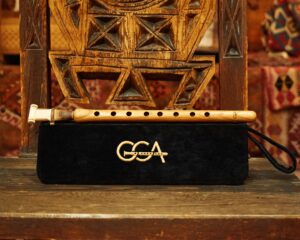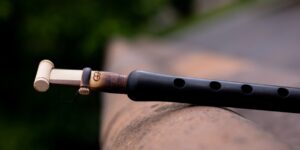
Duduk Special Gift Set in a Hard Case
Enhance Your Duduk Experience: A Special Gift Set in a Hard Case

The duduk, also known as the apricot pick, is an Armenian musical instrument composed of two primary components.
The first part consists of a cylindrical wooden pipe adorned with ten holes. Nine of these holes produce different pitch sounds, while the tenth hole is designated for tension control.
The second part is known as the sound producer, often referred to as the “chamois.” Within the reed of this component lies a spring that regulates the reed’s opening, and at the reed’s upper end, you’ll find a valve, delicately designed to naturally close after playing.
Duduk comes in various types, each with its unique characteristics:
In general, larger duduks with a bold sound are primarily used for melodies, while smaller duduks, which produce sharper tones, are favored for playing dance music.
Proper care of your duduk, especially the reed, is crucial to maintaining its performance. The reed plays a pivotal role in this regard. It operates when the two reeds are separated, making it open. There are two primary instances when the reed is opened:
High Humidity: In very humid climatic conditions, the reed may naturally open.
Water Filling: You can intentionally open the reed by filling it with water. To do this, pour water into the back of the reed, filling it to about half its size. After this step, be sure to drain the excess water.
The waiting period after filling the reed with water typically ranges from 15 to 20 minutes. The duration may vary depending on the specific type of reed you have. Some reed types open earlier, while others open a bit later. To ensure proper care, make an effort to prevent water droplets from falling onto the reed’s outer layer.
After waiting for 15-20 minutes, open the valve of the reed slightly to allow some steam inside, which will help gauge the degree of reed opening. Adjust the volume control to your liking. It is customary for players to use one hand to play a few notes while using the other hand to secure the opening, depending on their comfort.
After your playing session, it’s essential to close the reed with the valve and lift the spring to prevent its back part from sitting down. For long-term care, it’s advisable to keep your duduk dry and store it in a dry location to ensure its longevity and optimum performance.

Enhance Your Duduk Experience: A Special Gift Set in a Hard Case

Duduk Instrument Prices There are a number of factors that can affect
GGA represents professional musical instruments, that are recognized all over the world. The instruments are exclusively hand-made works. Feel the spirit of the orient music.